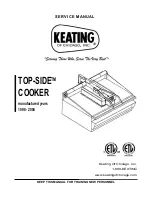
15
Sous Vide Frequently Asked Questions
How do I vacuum-seal food before cooking sous vide?
• Most foods cooked sous vide are sealed in bags using a vacuum
sealer. Use heat-safe bags labeled as suitable for sous vide. Follow
vacuum sealer manufacturer directions for vacuum-sealing bags.
• Any foods cooked with more than a small amount of liquid should not
be vacuum-sealed.
• When cooking fish, do not vacuum the bags tightly. About 75% is
desirable, or use the water displacement method.
• Food may be sealed in bags in advance and stored in the refrigerator
overnight before cooking to save time.
Can I sous vide without a vacuum sealer?
• Yes. Vacuum sealers are not required for foods cooked sous vide.
• Bags that are heat-safe, BPA-free, and PVC-free are safe for sous
vide cooking. Most name-brand resealable bags and bags made for
vacuum sealing will list their information on the package.
• Any foods cooked for less than 8 hours can be sealed in heat-safe
resealable plastic bags using the water displacement method:
1. Place food in bag and remove as much air as possible.
2. Close bag leaving 1-inch (2.5 cm) opening at the top.
3. Carefully submerge the bottom of bag in water until food is covered.
The pressure of the water will squeeze the air out of the bag.
4. Do not allow any water to enter the bag.
5. Gently squeeze any remaining air out of bag and seal.
Why is the water bath taking so long to reach the selected temperature?
• We recommend always filling the vessel with warm water when
starting. When cooking at higher temperatures, around 150°F (66°C)
or above, you may want to fill the vessel with hot water. A small
amount of boiling water can be added if desired to speed up the
heating process further. The temperature of the water can be checked
at any time during the heating process by pressing the TEMP button.
If water is hotter than the selected temperature, unit will display HOT.
Add ice cubes to lower temperature.
Is food safe to eat even though it is cooked at a lower temperature than
I use in other cooking methods?
• Yes. Cooking sous vide is just as safe as traditional cooking methods.
While the higher cooking temperatures of traditional methods may
pasteurize your food more quickly, those high temperatures may also
dry out food and yield an uneven and less appetizing result.
• Times and temperatures provided in the chart on page 7 are what
is necessary for pasteurization. Food safety is determined by a
combination of what you are cooking, how long you cook it, and at
what temperature.
• To minimize any risk of foodborne illness, always start with the
freshest possible foods and use safe handling practices. For
more information on safe internal cooking and pasteurization
temperatures, consult www.foodsafety.gov or fsis.usda.gov.
Can frozen foods be cooked sous vide without thawing first?
• Yes, but keep in mind that adding frozen food to the water bath will
lower the water temperature. A general rule is to add an extra hour
to the cooking time in order to allow meat to fully thaw and reach the
desired temperature.
















































